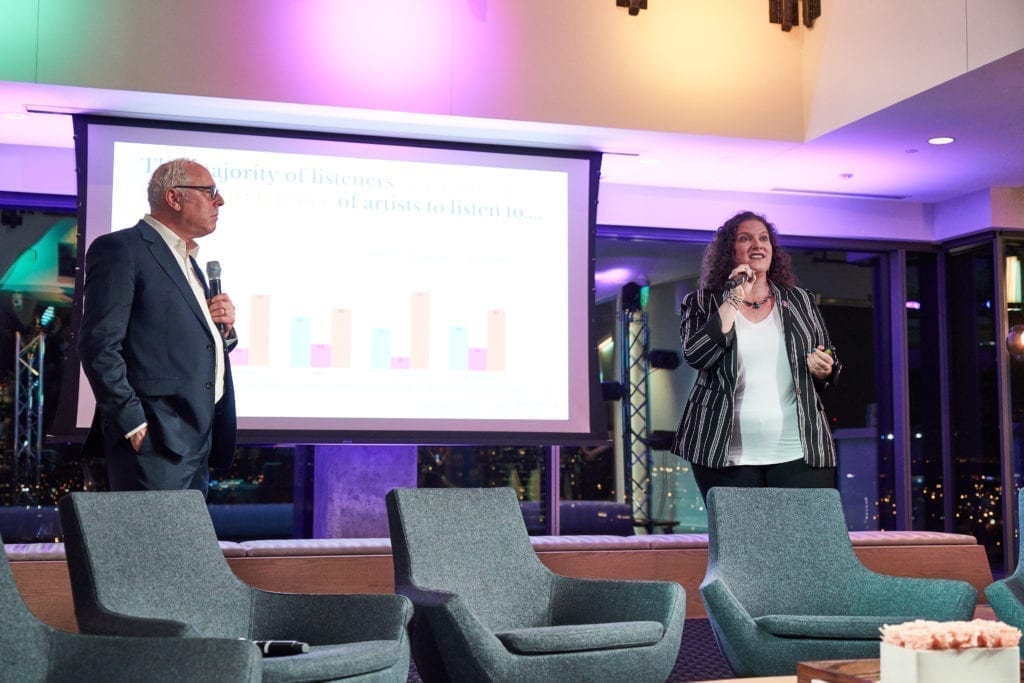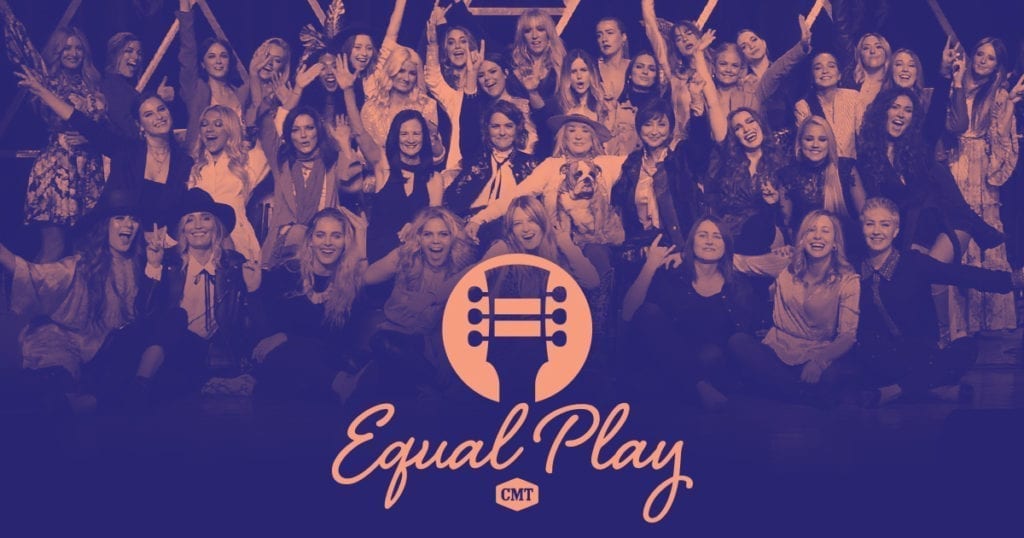
Last Tuesday evening, my colleague Sam Milkman and I had the pleasure and privilege of presenting our findings from a recent study to a room full of Country industry folks—performers, agents, publishers, reporters, etc.—several stories above the streets of Nashville. I’m admittedly bad at estimating numbers of people in a room, but I counted a good number of emphatic head nods, a few breakouts of applause, and a couple of vocalized statements of agreement, so I think we were talking to about 75 people.

Sam Milkman and Jessica Lichtenfeld present at the CMT Equal Play Campaign panel discussion in Nashville. Credit: Daniel Brown for CMT/ViacomCBS
The crowd was gathered to launch CMT’s Equal Play initiative; back in January, the cable net, a ViacomCBS network, announced that it would devote half of its video hours to female artists. This is, arguably, a Big Deal—no network has, as far as I can remember, made such a bold statement with its programming.

The move was inspired by Leslie Fram, CMT’s SVP of Music Strategy and a longtime radio personality and programmer. Leslie is also a founder of Change the Conversation, an organization devoted to improving the environment for female artists in Country music, and she is incredibly passionate about making sure female Country artists—both newcomers and well-established performers—get their due.
It has long been understood that many Country radio programmers limit the exposure of female artists on their stations and have often placed limits on how many songs by female artists that can be played per hour. Journalist Chris Willman tweeted back in January that KKGO in Los Angeles had played two songs by female artists in a row, and “can’t they get fined for that?” Little did Chris know at the time, we had already presented our study to CMT that focused on audience perceptions of this very issue. (Chris was there on Tuesday, by the way, and got a nice round of applause.) How’s that for parallel ideas?
You see, CMT approached us in the Fall of 2019 looking for a research partner to answer some questions about the Country audience. CMT’s goal in commissioning this research was to dispel some of the “conventional wisdom” about Country radio listeners:
- Country fans aren’t interested in hearing songs by female artists
- Listeners think male Country artists have better voices and sing better songs than female Country artists
- Listeners don’t think women play a huge role in current Country music, past or present
- Country listeners don’t want to hear more women on the radio
Sam and I collaborated with the Insights team at CMT—with an assist from our founder, Jon Coleman—to design a survey in which we asked direct questions of the Country radio audience. Our goal was to figure out whether these pieces of “conventional wisdom” were real or imagined, and whether the Country radio audience in the US would be open to hearing more female artists on Country radio stations.
What we found was heartening. Not only are women recognized for the major role they’ve played in the history of Country music and for their current contributions, but Country listeners are also overwhelmingly open to hearing more from women on Country radio. 7 in 10 listeners agree that they want to hear more from women in Country radio and 84% agree with the statement, “I want equal play for female artists on Country radio.” And when we asked our respondents whether they prefer male artists to female artists, over half said they have no preference. Why? Well, at the end of the day, for this majority of Country radio fans, “a good song is a good song, no matter who sings it.”
As we shared this information with the crowd on Tuesday, you could feel the support and the buzz. We’re at a time where many female up-and-coming Country artists have great songs—that they write themselves or for other artists—and stories to tell, and they’re not afraid to be loud. This room of publishers and managers was so supportive, men and women alike, and committed to driving change in the industry. The radio people in the room talked about opening playlists and letting more women in, and not allowing old industry conventions to hold them back from playing great new songs. Publishers talked about encouraging female songwriters and making space for them. Everyone recognized that change won’t happen overnight, but conversations like the ones on Tuesday are a great start to acknowledging that conventional wisdom no longer applies.
And we at Coleman Insights were part of it. Good research provides an understanding of the audience and, in cases like these, the insights you need if you think it’s time to change a conversation.

Props to Leslie Fram and CMT for doing their part in seeking answers and being actionable.
I 100% agree there is a strong need for for more female voices on Country radio,. However, if a finger is to be pointed, it needs to include the record labels. (Just to be clear, I do think radio is culpable, as well…but not the scapegoat/villain radio is being made out to be. )
Radio is only able to be a united front to make a change for more women in Country radio only if we have the product to play. You can’t make things if you don’t have the supplies.
Up to this point, the labels have done little to nothing to draw attention away from radio being the only problem this conversation. Had they been prioritizing woman as part of their rosters, this conversation would not exist. For this reason, I find this issue to be placed in the wrong camp. Artists are an investment. It doesn’t seem that anyone is advocating for the investment.
You all got a lot of great insights to the desire for Country radio to incorporate more women into the format, Just as strongly, I also see Mark Ramsey’s point. (in RadioInk https://radioink.com/2020/02/21/research-country-programmers-do-not-know-their-audience/). The audience does not see the disparity as a listening issue, nor do they hold the belief that too many women in a row is a bad thing. (The female limit rule that was tweeted out was stupid…stupid to have such a rule and just as stupid to tweet.)
Good music is good music. Research supports that. Ticket sales supports that. Streaming numbers support that.
That is a mantra we use at our station. We seek out the best music, always. It is our obligation to deliver the best all the time. Every week we seek out great music and we specifically search for great songs from the women of Country music. Currently, women encompass 45% of our playlist. But they are great SONGS, not just because of their gender. If we added women to the playlist just because of gender, we would not doing a service to the format, the radio industry and women, as a whole.
All points from your research and Mark’s are valid, but shaming radio is not where the conversation should start and end, it should be PART of the greater conversation. But what artist (of any gender) is going to call out their label for doing them wrong? That’s like smack talking your employer in the Wall St. Journal and expecting a raise.
If there is going to be a change for gender equality in Country radio, the labels need to actively seek out new talent, work with them, have an A&R department that does more than watch YouTube videos for the next big thing, find better songs for these women, have producers who can make their songs stand out as being more than just another Carrie Underwood/Miranda Lambert sound-a-like. Carrie and Miranda are amazing, but the female artists of tomorrow deserve to have as unique of a sound as the men. When this happens and the labels become a bit more introspective as to their role in this PR nightmare, only then will a change begin.
I think it’s the safe and popular thing to say but it’s another thing to actually really mean it. I hope weekly and monthly research will prove this article to be true. The 25 years I’ve seen of weekly and quarterly music research says otherwise.